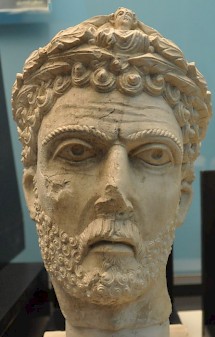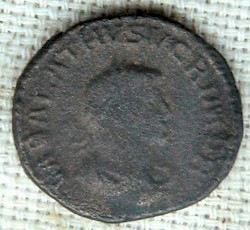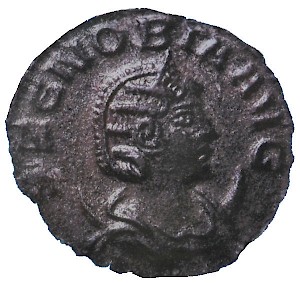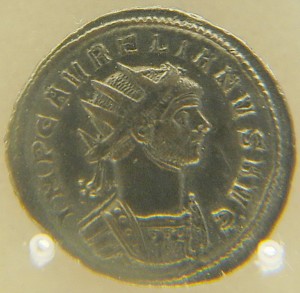Palmyra (4)
Q5747Palmyra or Tadmor: oasis in the desert between Damascus and the Euphrates, important trade center, and capital of a semi-indepent state in the third century CE.
Empire
To the east of Palmyra, beyond the Euphrates, was the Parthian Empire. Just like Rome, it had existed since time immemorial, although it was not a central state, but more like a confederation of city states, kingdoms, and tribes. Among those city states was Charax, one of Palmyra’s trade contacts. Among the old kingdoms was Persis, ruled by the Sasanians, who claimed to be descendants of the Achaemenids.

In 224-226 CE, their leader Ardašir I revolted against the Parthian Artabanus IV, and the Persians took over the oriental empire. The new “king of kings” proceded to attack the Roman cities of Nisibis and Edessa, and soon, the Euphrates valley was a war zone: the Roman emperor Severus Alexander led a counterattack (visiting Palmyra in 232), and in the end, the status quo was restored. However, Ardašir’s son Shapur I resumed the war, and was very successful. The emperor Gordian III was killed in action (244), and Shapur could boast – with some justification – that he had put Gordian’s successor Philip on the Roman throne. In 260, he even captured a Roman emperor, Valerian, in the neighborhood of Edessa.
By then, several things had changed in Palmyra. It had had the status of a Roman colonia, with a municipal administration, but after c.251, it had only one leader, a man named Odaenathus. He is called an exarch, which means something like “leader of an outpost”, but we do not know precisely what this means. Anyhow, Palmyra remained within the Roman zone of influence and in 258, Odaenathus served as consul. When Valerian was captured in 260, an experienced leader was there to protect the Roman Empire.

There was a lot of work to do. Valerian’s son Gallienus had to cope with several usurpers, like Postumus in Gaul and Quietus in Syria. Odeanathus’ first act was to attack Shapur’s army, which returned from Edessa to the south, in the valley of the Euphrates. Odeanathus’ victory was undeniable and the Sasanian Persians never really retaliated. In 261, Odaenathus isolated Quietus in Emesa and terminated his usurpation. In return for the services that the Palmyrene leader had rendered, Gallienus accepted Odaenathus as dux Romanorum (“leader of the Romans”) and corrector totius Orientis (“reorganizer of all the East”). He is also called rex regum, a translation of the Iranian “king of kings”.
The titles are less important than the fact that Gallienus allowed his ally to command Roman troops. Using them, he attacked the Sasanian capital in Babylonia, Ctesiphon, in 262 and 267. This was perhaps a bit more than Gallienus had bargained for: in 268, when Odaenathus was on his way to attack a group of Gothic marauders in Cappadocia, he and his son Herodian were assassinated by one Rufinus, who is believed to have acted on Gallienus’ orders.
 Palmyra, Colonnaded street, capital |
 Palmyra, Funerary temple |
 Palmyra, Tombstone of Tamma and Šabhei |
 Palmyra, Temple of Ba'al, Cupid with a parasol |

As successor of Odaenathus, his son Vaballathus was recognized, but because he was too young, his mother Zenobia acted as regent. It was most unusual for a woman to be a ruler, but these were unusual times: the emperor Gallienus had died – and he had not been able to reunify the Roman Empire, which had by now lost its western provinces to a “Gallic Empire”. Now, the Palmyrenes abandoned their allegiance to Rome as well: in 269, the Palmyrene Empire invaded Anatolia and even reached Ancyra (modern Ankara).
The Palmyrenes could have some success because the new Roman emperor Claudius II was occupied at the northern frontier, where barbarian tribes had broken through. One of these groups had built ships and had started to live as pirates in the Aegean Sea, forcing the Roman general Probus, the prefect of Egypt, to counterattack. Since Egypt was now without garrison, the Palmyrene general Zabdas simply occupied it. Probus returned, defeated the Palmyrene garrison, but in 270, the Palmyrenes returned and reconquered the land of the Nile. Probus committed suicide.

At about the same time, Claudius II was killed in action. The chaos in the Roman world was complete. The Palmyrene government seems to have been content with its conquests: they now had access to the Red Sea, which allowed the merchant empire to resume trade with India, something that had been impossible since the Sasanians had blocked the Persian Gulf. Coins were minted, showing Zenobia on one side and the new Roman emperor Aurelian on the other, as if Palmyra was looking for a deal with the central government.

Aurelian was not interested. In 272, he launched a campaign to the east, where he captured Palmyra. Zenobia was captured – her fate is recorded in conflicting sources, and we have no idea what happened to her.note In any case, the Palmyrenes were not willing to admit defeat and revolted in 273. Aurelian returned and sacked the city, which meant the end of Palmyra’s prosperity. (It should be noted, however, that there are hardly any archaeological traces of the sack of the city.) The new trade center, where eastern and western merchants would meet, was Nisibis.
 Palmyra, Jupiter Heliopolitanus |
 Palmyra, Ankle cuff |
 Palmyra, Šadrafa |
 Palmyra, Capital: the god Abgal and a dedicator |